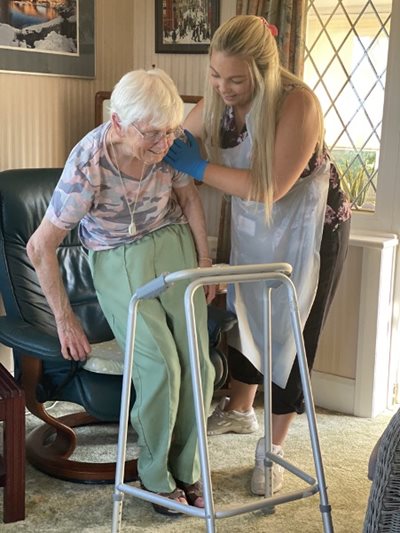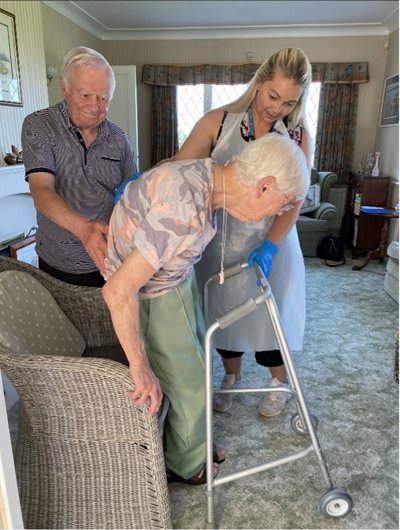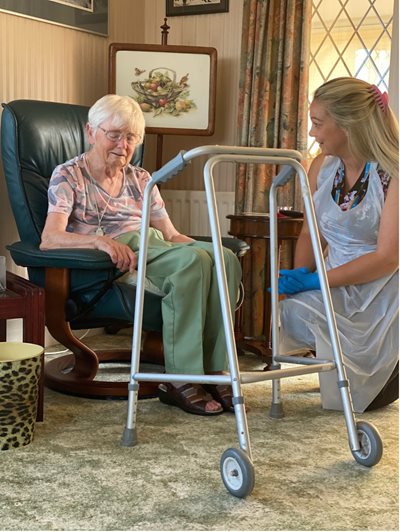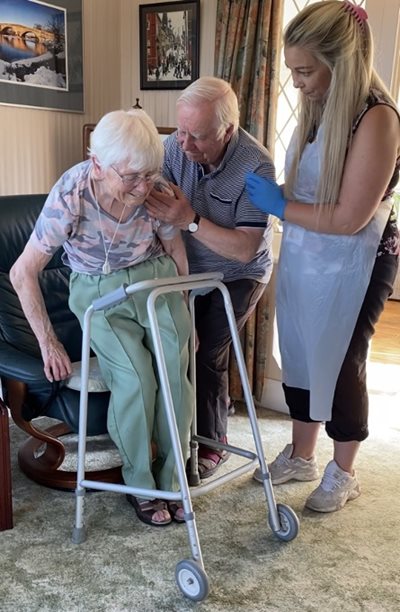Jean - Customer Case Study into reducing the risk of falls at home
Published: 13/12/2023
What happened, what did you do, why did you do it, who did you inform, who did you work with, who did you reports things to?
Jean has been a customer of Bluebird Care for over 4 years. Living with Parkinson's Disease, Jean has recently been struggling more with her symptoms, particularly around her mobility. Jean had a number of falls in her home Jean lives with her husband who is her main carer when the Bluebird Care team aren’t supporting Jean. Jean’s husband, Norman, was particularly keen to learn how to help prevent Jean from falling as much and her Bluebird Care team were keen to reduce these risks also. Following several Occupation Therapist visits, Jean already had a number of aids in place to support her mobility including a Zimmer frame (one upstairs and one downstairs), a stairlift, support handles around the home, a shower chair, perching stools, a frame around her toilets and an alarm pendant. The falls that Jean had tend to happen outside of Bluebird Care visits. Since Jean and her husband were becoming increasingly concerned about falls, we offered to visit their home and provide some bespoke and free moving and positioning training with Sophie Bellwood (Registered Care Manager and Trainer) at Jeans house with her and Norman. The idea was to give Jean and her husband some practical tips and new techniques to use when helping Jean get round at home. Jean and her husband were really pleased about this offer and accepted. They were both eager to learn some new techniques to minimise the risk of Jean falling in the future.

Since providing our free training to Jean and Norman, Jean's falls have reduced by 50 percent.
In June 2023, Sophie and Sheree Jenman (Director) attended Jean’s home and met with her and her husband. Sophie listened to their concerns, why they thought Jean was falling and they discuss what could be put in place to help. Jean explained that she normally falls when she is feeling quite tired and when standing up or when she is alone. Her husband does not leave Jean in the house for long but does run short errands or tend to the garden. Jean is happy to be at home on her own and can normally stand and mobilise independently. She wears an alarm pendant which she can press if she falls. Jean and her husband said that Jean has fallen whilst he has been out, and she has not pressed her alarm pendant due to forgetting. Sophie suggested that Jean tries a falls detector which she can wear on her wrist. This type of falls detector will automatically alert the Telecare team (and Norman) if she was to fall. Sophie explained that this would likely provide peace of mind to Jean and her husband as Jean will not have to remember to press the alarm should she fall and this would alert Jean’s husband as soon as she falls, rather than him arriving home to finding Jean had fallen, not knowing exactly how long she has been there for. Both Jean and her husband agreed that this would provide peace of mind and that they would try it.
Jean was sitting in a low chair in her lounge and when asked by Sophie, she said this is the chair she normally sits in. Sophie asked Jean to show her how she would normally get up from the chair and as it was quite low, Jean did struggle. Sophie suggested that Jean maybe tries a chair that is taller. Jean said she has a chair she can use instead of the low one. When we brought the slightly higher chair through, Jean found it much easier to stand from sitting (with support). Sophie demonstrated techniques for Jean and her husband to use to help Jean when standing. She advised Jean to move to the front of the chair, use the chair arms to stand, take her time and showed Jean’s husband how to physically support Jean safely, protecting himself and Jean. Sophie demonstrated this with Jean first and then guided Jean’s husband whilst he carried out the techniques. He said that it felt safe, sturdy and that Jean felt supported whilst he was helping her to stand up.
Jean has a rise and recline chair in her lounge and Sophie suggested we try that one. Jean said that she doesn’t normally sit in this chair but found it comfortable when she did sit in it. Sophie showed Jean how to operate the chair using the remote and how to rise it when she was standing. Jean again found this really helpful.
Sophie spoke with Jean and her husband about the possibility of trying a stand aid. Jean said that she had seen an Occupational Therapist a short while back but because Jean was feeling better than she was now, they had only suggested some exercises through a physiotherapist, which she has been carrying out. Sophie explained what a stand aid was and how they work. She explained that they are designed to help people remain independent and are there only to help with standing and sitting (if required due to mobility issues). Jean and her husband were interested in this and said they would try anything that would help them both. Sophie offered for Bluebird Care to contact the Occupational Therapist team on Jean’s behalf to help. Jean and her husband were very grateful of this and said that they would be more than happy for Bluebird Care to make this referral. It’s extremely important to Jean and her husband for Jean to remain at home so they were both very grateful for the support provided by Bluebird Care, including the training provided that day.
Jean and her husband were also reminded that Bluebird Care can provide additional care if required when Jean’s husband goes out. They are both aware of this and know they can contact the office to arrange short notice, additional care if needed, as they have done in the past.
After the visit, Sophie sent Norman a follow up email with details of who to contact regarding the falls detector, informative information about stand aids (what they look like and how they are used) and that she had asked a colleague to make a referral to the Occupational Therapists on Jean’s behalf, as agreed.

So what?...........What was the overall outcome and how did this positively affect our customer?
A referral was made to the Occupational Therapist Team and Jean’s husband has been in contact with Sophie since to say that he finds the techniques to support Jean to stand extremely helpful. He said he feels a lot more confident moving forward and feels well equipped with techniques which ensure he is protecting himself and Jean from injury when supporting her with moving around their home. Jean has expressed that she feels safer in her home and is looking forward to the Occupational Therapists coming to hopefully provide some further equipment.
Since the training, the number of falls Jean has experienced have decreased by 50%, which is a safer outcome for Jean. The Bluebird Care Team continue to work closely with Jean and Norman to monitor her safety. Jean and her husband have been advised to keep a wheelchair or a seat close to where Jean is walking so she can take a seat and have a rest to break up the walk, if needed.
Jean now has a falls wrist alarm in place following Sophie’s advice which has provided peace of mind to both her and her husband.

How did we demonstrate outstanding practice in accordance with Care Quality Commission (CQC) standards?
We met and exceeded the expectations of each of the following Quality Statements issued by thee Care Quality Commission (CQC):
Safe
Safety is a priority for everyone and leaders embed a culture of openness and collaboration. People are always safe and protected from bullying, harassment, avoidable harm, neglect, abuse and discrimination. Their liberty is protected where this is in their best interests and in line with legislation.
We have a proactive and positive culture of safety based on openness and honesty, in which concerns about safety are listened to, safety events are investigated and reported thoroughly, and lessons are learned to continually identify and embed good practices.
We work with people to understand and manage risks by thinking holistically so that care meets their needs in a way that is safe and supportive and enables them to do the things that matter to them.
We work with people and our partners to establish and maintain safe systems of care, in which safety is managed, monitored and assured. We ensure continuity of care, including when people move between different services.
We work with people to understand what being safe means to them as well as with our partners on the best way to achieve this. We concentrate on improving people’s lives while protecting their right to live in safety, free from bullying, harassment, abuse, discrimination, avoidable harm and neglect. We make sure we share concerns quickly and appropriately.
We work with people to understand and manage risks by thinking holistically so that care meets their needs in a way that is safe and supportive and enables them to do the things that matter to them.
We detect and control potential risks in the care environment. We make sure that the equipment, facilities and technology support the delivery of safe care.
We make sure there are enough qualified, skilled and experienced people, who receive effective support, supervision and development. They work together effectively to provide safe care that meets people’s individual needs.
Effective:
People and communities have the best possible outcomes because their needs are assessed. Their care, support and treatment reflects these needs and any protected equality characteristics. Services work in harmony, with people at the centre of their care. Leaders instil a culture of improvement, where understanding current outcomes and exploring best practice is part of everyday work.
We maximise the effectiveness of people’s care and treatment by assessing and reviewing their health, care, wellbeing and communication needs with them.
We plan and deliver people’s care and treatment with them, including what is important and matters to them. We do this in line with legislation and current evidence-based good practice and standards.
We work effectively across teams and services to support people. We make sure they only need to tell their story once by sharing their assessment of needs when they move between different services.
We support people to manage their health and wellbeing so they can maximise their independence, choice and control. We support them to live healthier lives and where possible, reduce their future needs for care and support.
We routinely monitor people’s care and treatment to continuously improve it. We ensure that outcomes are positive and consistent, and that they meet both clinical expectations and the expectations of people themselves.
We tell people about their rights around consent and respect these when we deliver person-centred care and treatment.
Caring:
People are always treated with kindness, empathy and compassion. They understand that they matter and that their experience of how they are treated and supported matters. Their privacy and dignity is respected. Every effort is made to take their wishes into account and respect their choices, to achieve the best possible outcomes for them. This includes supporting people to live as independently as possible.
We always treat people with kindness, empathy and compassion and we respect their privacy and dignity. We treat colleagues from other organisations with kindness and respect.
We treat people as individuals and make sure their care, support and treatment meets their needs and preferences. We take account of their strengths, abilities, aspirations, culture and unique backgrounds and protected characteristics.
We promote people’s independence, so they know their rights and have choice and control over their own care, treatment and wellbeing.
We listen to and understand people’s needs, views and wishes. We respond to these in that moment and will act to minimise any discomfort, concern or distress.
Responsive:
People and communities are always at the centre of how care is planned and delivered. Their health and care needs of people and communities are understood and they are actively involved in planning care that meets these needs. Care, support and treatment is easily accessible, including physical access. People can access care in ways that meet their personal circumstances and protected equality characteristics.
We make sure people are at the centre of their care and treatment choices and we decide, in partnership with them, how to respond to any relevant changes in their needs.
We understand the diverse health and care needs of people and our local communities, so care is joined-up, flexible and supports choice and continuity.
We provide appropriate, accurate and up-to-date information in formats that we tailor to individual needs.
We make it easy for people to share feedback and ideas or raise complaints about their care, treatment and support. We involve them in decisions about their care and tell them what’s changed as a result.
We make sure that everyone can access the care, support and treatment they need when they need it.
We actively seek out and listen to information about people who are most likely to experience inequality in experience or outcomes. We tailor the care, support and treatment in response to this.
We support people to plan for important life changes, so they can have enough time to make informed decisions about their future, including at the end of their life.
Well-led:
There is an inclusive and positive culture of continuous learning and improvement. This is based on meeting the needs of people who use services and wider communities, and all leaders and staff share this. Leaders proactively support staff and collaborate with partners to deliver care that is safe, integrated, person-centred and sustainable, and to reduce inequalities.
We have a shared vision, strategy and culture. This is based on transparency, equity, equality and human rights, diversity and inclusion, engagement, and understanding challenges and the needs of people and our communities in order to meet these.
We have inclusive leaders at all levels who understand the context in which we deliver care, treatment and support and embody the culture and values of their workforce and organisation. They have the skills, knowledge, experience and credibility to lead effectively. They do so with integrity, openness and honesty.
We foster a positive culture where people feel that they can speak up and that their voice will be heard.
We have clear responsibilities, roles, systems of accountability and good governance. We use these to manage and deliver good quality, sustainable care, treatment and support. We act on the best information about risk, performance and outcomes, and we share this securely with others when appropriate.
We understand our duty to collaborate and work in partnership, so our services work seamlessly for people. We share information and learning with partners and collaborate for improvement.
We focus on continuous learning, innovation and improvement across our organisation and the local system. We encourage creative ways of delivering equality of experience, outcome and quality of life for people. We actively contribute to safe, effective practice and research.

Feedback from our customer
“I feel much more confident when supporting Jean now thanks to Sophie's training, I have grown in confidence when supporting her and we’re so pleased that things are moving with the Occupational Therapists and District Nurses now. The new falls alarm is working well, it gives me a lot better peace of mind and Jean has gotten used to it now . She's had less falls in the latter part of this year than she had in the first 6 months of the year. That's great progress! – Feedback from Norman, Jean’s husband.

